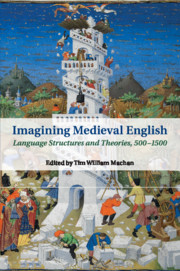Book contents
- Imagining Medieval English
- Cambridge Studies in Medieval Literature
- Imagining Medieval English
- Copyright page
- Contents
- Figures
- Tables
- Notes on contributors
- Book part
- I Introduction
- II Organizing ideas
- III The continuities of language
- IV The discontinuities of English
- V Retrospection
- Bibliography
- Index
- Cambridge Studies in Medieval Literature
- References
Bibliography
Published online by Cambridge University Press: 18 December 2015
- Imagining Medieval English
- Cambridge Studies in Medieval Literature
- Imagining Medieval English
- Copyright page
- Contents
- Figures
- Tables
- Notes on contributors
- Book part
- I Introduction
- II Organizing ideas
- III The continuities of language
- IV The discontinuities of English
- V Retrospection
- Bibliography
- Index
- Cambridge Studies in Medieval Literature
- References
- Type
- Chapter
- Information
- Imagining Medieval EnglishLanguage Structures and Theories, 500–1500, pp. 281 - 311Publisher: Cambridge University PressPrint publication year: 2016



